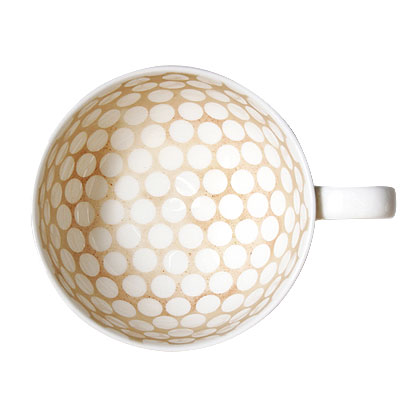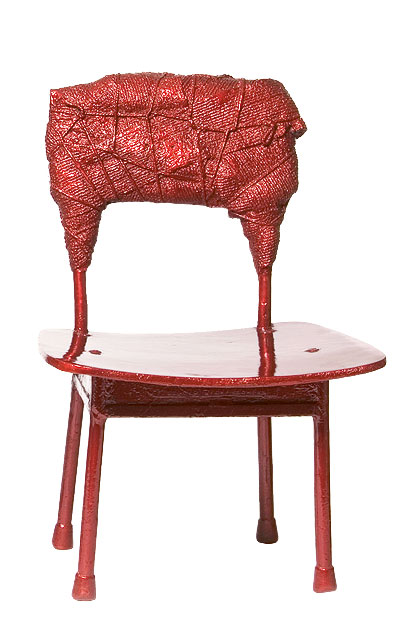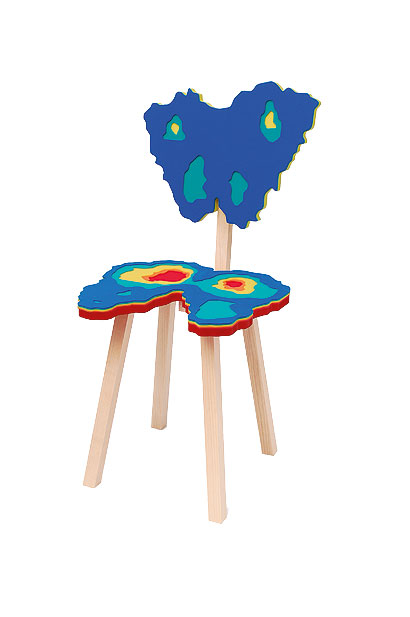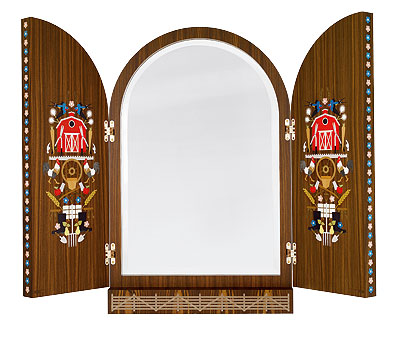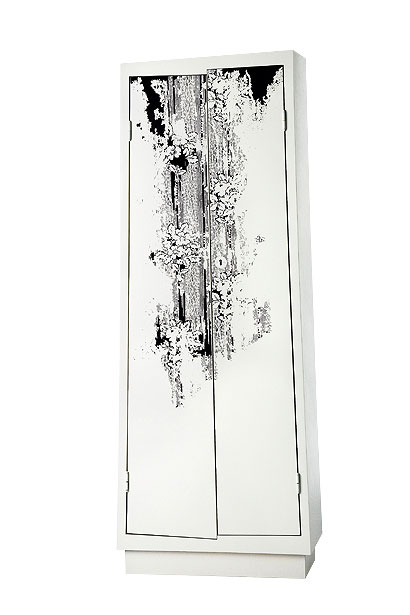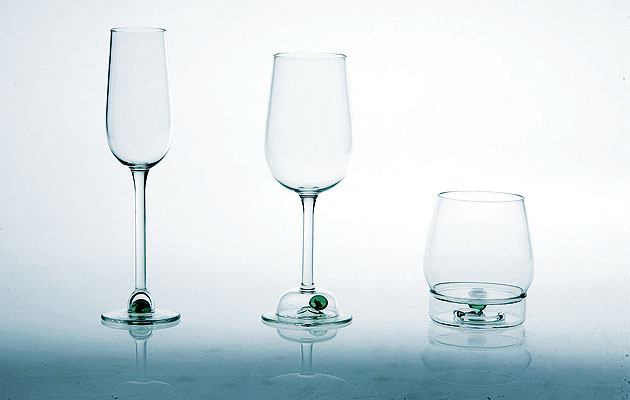|
Is design playing with your emotions? What objects are most special to you? Which do you love? Are there any possessions with which you feel you have an intimate personal connection? These objects could be gifts from loved ones, or heirlooms, handmade things, or items acquired in exotic circumstances. They have a history, and are a source of good feelings. And for some designers those good feelings are the Holy Grail – they want their work to provoke an immediate emotional bond with the consumer. For instance, there are decorated chairs that “bring back a long lost sentimental value” by using traditional embroidery. There are wine glasses with simple games built into their bases which are “supposed to evoke childhood memories and instill a sense of play into everyday objects”. Of a tablecloth that reveals a pattern when wine is spilled on it, one design website wrote: “[The designer] believes that this creates stories and can contribute in giving the products sentimental value – important in a society where we seem to have an increasingly superficial relations to the objects we surround ourselves with.” The Dutch designer Wieki Somers wrote of her recent collection based on the improvised seating of roadside merchants in China: “The stools, probably cherished a lifetime, testify to a long history in which both the maker and the user have left their traces.” These works – or at least the rhetoric attached to them – could be called “emotional design”, or “sentimental design”. Beyond being simply useful or attractive, they aim to forge an immediate emotional connection with the user, simulating the bond that would arise with a long-owned and much-loved object. Experience, the story or background of an object, has become vitally important – almost an additional element of its function. And the emotional connection that consumers appear to want doesn’t even have to be personal – it can be somebody else’s, such as that of a Chinese roadside merchant or an old Scandinavian woman who loved embroidery. We’re seeing the rise of design with false memory syndrome. “The absolute saturation of commercialisation and consumption has left us really cold, and now we’re looking for a warmth,” says creative strategist Burnham, who is directing Trust Design, a project exploring this “new functionality”. “I don’t want to know that the moment my credit card was swiped was when this object was brought to life – that doesn’t do enough for me. I want to understand this product, where does it come from, or I want to understand this product in terms of its narrative.” Maxim Velcovsky is among the designers exploiting memory and history in design, producing work that is self-consciously nostalgic, based on the kitschy artifacts he remembers from his childhood in communist Czechoslovakia. His more recent work has taken a more impressionistic approach to history, such as the 2007 Catastrophe vases, which look like they have just been unearthed from a bombsite, and the 2009 Underground Souvenirs, objects caked in minerals from a hot spring and resembling fossils. “The thing is I can say something through the object, it doesn’t have to be strictly purist or functional,” he says. “It seems to me that there’s always a role for emotion in design – the other route is Jasper Morrison and conserving batteries … the mechanical ways of developing design. And I think that nowadays we are much more free to produce these things ourselves as designers.” It’s not just objects that hark back to folk traditions, childhood memories or street improvisation that can form this deeper emotional bond with the consumer. Forming this bond is a key motive of the customisation cults that fall under the term “design hacking” (explored in icon 082), and behind a growing number of products that have some user alteration built in, such as the tablecloth mentioned above, or Bethan Laura Wood’s Stain cups, which reveal a pattern by staining faster in predetermined places. In its recent range for Ikea, Swedish design studio Front also tried to incorporate this instant customisation. The PS Selma chair had a cushion like a flip-book, letting the user choose a pattern. Front also wanted the user to be able to rearrange the wooden elements of the PS Svarva floor lamp, but the idea was quashed by the flatpack furniture giant (icon 070). “It’s a bit like buying a frozen pizza but then sticking some stuff on top of it to make it feel like you’re doing the cooking,” says Gareth Williams, curator of furniture at the Victoria & Albert Museum in London and senior tutor in Design Products at the Royal College of Art. “That’s all part of emotional design, it’s making you feel that you’re part of it, that you’ve done it together.” Last year Williams curated Telling Tales at the V&A, a collection of design art rooted in narrative tradition, history and folklore, but he’s sceptical about “emotional design” and scornful of objects that substitute nostalgic gestures for quality. “It’s actually spurious,” he says. “Ooh look, it’s reminding us of granny … my granny was a modernist. It’s so one-dimensional. They’re trying to add distinction to their works, they’re trying to add value and distinction over and above it just being functional, they want us to choose their teapot over someone else’s teapot.” Why is this distinction so important? How does it work? “Designers worldwide are realising that the price premium you can charge for design can be a lot higher if there is this emotional connection,” says Geoffrey Miller, associate professor of psychology at the University of New Mexico and author of Spent: Sex, Evolution and the Secrets of Consumerism. As Miller explains, these different strands in design – nostalgia, sentiment and built-in customisation – actually stem from the same set of impulses: they lead to objects that we believe, on a subconscious level, will make us more attractive to the opposite sex. “The only real payoff for having these products comes from being able to talk about them – conversation is one of the ways that people get attraction and status,” Miller says. “If you can talk in an interesting way about a product … it becomes what we call a conversation piece, and it reveals much more about your personality, identity and background.” Objects designed with the emotional payoff built into them are, we believe, more interesting, and therefore make us more interesting. Although there is nothing particularly new about that equation, Miller sees it as becoming more and more pronounced as consumers become more sophisticated and less satisfied with conventional status symbols, and designers become more complicit in adding the “emotional” dimension and enjoying its price premium.
Catastrophe vase by Maxim Velcovsky, 2007 But there are signs that emotional design is having a deep effect on the way that designers think about their work. Williams says that emotional language is increasingly being used by the students he sees. “It’s almost as if they’re method actors, [asking] ‘what’s my motivation, what’s my emotional reason for designing this’,” he says. “They say ‘I think it’s really important that people reconnect to the things around them and I’m a designer who wants to make people appreciate things more’ – but you can’t make people do things, I didn’t think that was a designer’s job.” Nevertheless, the emotional language runs deep in the students’ approach. Rather than focusing on making work that functions well and looks good, they are trying to connect with the user on a kind of spiritual level quite separate from the physical characteristics of a product. Williams suggests that they feel more like psychologists than designers, supplying something over and above an object. “It’s about supplying a need that you never even knew that you had, some kind of emotional emptiness that can only be filled by design,” Williams says. “It’s loopy really, isn’t it.” It may be loopy, but it is perhaps the inevitable result of a highly developed capitalist system with a super-abundance of products on the market. To differentiate their product from the next five, designers feel they need some extra quality or value – and this is often sentimental, an appeal to memory or story. Emotional thinking and rhetoric in design, then, has more to do with marketing than design: making an object stand out rather than improving it. That, in turn, is a product of the changing way that people consume design – the field is being devoured from within by image. “People consume the majority of things now not by using them but by looking at them,” says Sam Hecht, partner of Industrial Facility, a studio specialising in the minimal, functional products that are a world away from emotional design. “On a daily basis thousands upon thousands of new chairs are looked at, commented on, thought about and in a very bizarre way critiqued without anyone ever, ever sitting upon them. This is a problem.” Driven by the internet, design has in a way dematerialised into a miasma of JPEGs. Faced with the possibility that a design might live or die by its pixellated image alone, designers are changing the way that they work and think. “Most of these things that you witness on a daily basis in the media, they don’t actually exist in a meaningful reality – you can never use them, you can never consume them, they just exist,” Hecht adds. “The very people who are producing the work are producing it to feed the image.” Work is produced according to how it will be described in a picture caption: how it is described to an audience who will never see the real object. “You’re using words like ’emotional design’ because a person won’t actually experience it,” says Hecht.
Stain cup by Bethan Laura Wood, 2007
Chinese stool by Wieki Somers, 2007
Posture personalised chair by 5.5 Designers, 2008
PS Svarva lamp by Front for Ikea, 2008
Bavaria mirror by Studio Job, 2008
Hidden Layers cupboard by Folkform, 2009 |
Words William Wiles |
|
|
||
|
Losing Your Marbles glasses by Charlotte Moneypenny, 2009 |
||


